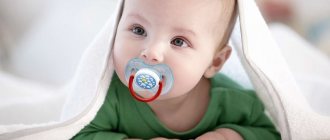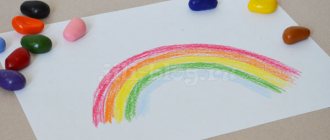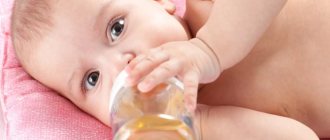The article contains detailed information on the issue of piercing a child's ears, including describing the basic techniques that are used for this, contains recommendations for caring for pierced ears, helps determine the appropriate age for the procedure, and answers many other questions.
The dilemma of ear piercing sooner or later occupies the thoughts of almost all parents of girls. Many doubts and questions arise. On the one hand, every mother is driven by the desire to make her princess even more beautiful and sweeter; on the other hand, there is a fear of making a decision without the conscious will of the child; on the third, there are health issues and the risk of undesirable consequences. How to find a middle ground, and when is the best time to decide on this procedure?
At what age can a child or girl’s ears be pierced?
girl with earrings
Naturally, there is no clear universal age for ear piercing. First of all, you need to honestly answer the following questions:
- Why do you want to pierce your child's ears?
- What are you most afraid of?
Causes:
- Perhaps you remember how scared you were and want to pierce your child’s ears as soon as possible
- I'm tired of how many people often ask whether you have a girl or a boy
- Everyone you know to your kids has already had their ears pierced, and you don’t want your child to fall behind in anything.
- the child asks very much himself
The most common fears:
- hurting a child
- negative consequences of a puncture
- making decisions for the child that he will not approve of at a conscious age
baby with pierced ears
If you are driven by the first three reasons, you must realize that you are doing this primarily for yourself. Think about it: if you were a child, you would approve of the same behavior of your parents. If you are sure that your baby will only thank you in the future for the ears pierced in early childhood, ear piercing will not cause harm if done responsibly. But if there are still doubts, it is better to postpone the procedure. You can get your ears pierced at any age if you wish.
The simplest case is when you are interested in ear piercing at the request of a child. All you need to do is study the issue from a medical point of view. Fortunately, there are few restrictions here either. Almost all representatives of medicine will recommend your age from 3 to 11-12 years. And if a child has made a decision on his own and asks to have his ears pierced, most likely he falls into this age range.
child trying on earrings
Age from three years is explained by the following:
- A younger child is more susceptible to inflammatory processes, which is possible during the piercing procedure. Many medications have an age limit of up to 2-3 years, so it may be difficult to get medical help in case of complications
- It is difficult to explain to a small child that during the healing period the ears should not be touched; the child grabs everything in sight, can bring in dirt, get caught in the earring or try to remove it
- Treatment of ears after piercing can bring discomfort to the child, and a little restless stubborn person may rebel against the unpleasant procedure
- Children's ears undergo changes; the final formation of cartilage and the auricle occurs, according to various estimates, by the 4th-6th year
- After three years, the child can already talk about his feelings and desires
Regarding concerns about pain, psychologists say that a child under 1.5-2 years of age most likely will not understand what happened to him and will not feel fear or pain. In contrast to older age, when children often want, but are afraid to get their ears pierced.
fear of ear piercing
However, it should be noted that in the first case, you will get rid of the problem of fear, but you risk showing selfish tendencies and imposing your desires on the child, and you will also have to approach the choice of a specialist and caring for the puncture as responsibly as possible due to the vulnerability of a very small person.
In the second case, the child’s choice will be conscious, but he will have to face a feeling of fear and anticipation of pain. In adolescence (after 12 years), you will still have to go through a complex and longer healing process.
In fairness, I would like to note that modern piercing techniques are much less painful than those with which our parents pierced their ears, but this did not stop those who really wanted to see beautiful stones in their ears.
How to prepare for your child's ear piercing?
the girl wants earrings
The first stage has been completed: the decision to pierce her ears has been made. Your next steps:
- study contraindications, if necessary, consult a doctor, choose a method of piercing
- decide on the location of the procedure
- wait for the right time
- if the child is not an infant and is already able to understand, you should first tell him, without intimidation, what awaits him so that he is psychologically prepared, but you should not “get too hung up”, since the child may become more nervous than the puncture procedure itself lasts
- provide proper aftercare
- buy the “right” earrings
When should children not have their ears pierced?
exclamation mark
With all the best desire, there are situations when ear piercing is undesirable or even contraindicated:
- in the presence of any ear diseases (only with the permission of an otolaryngologist)
- in case of diagnosing chronic and systemic diseases (diabetes mellitus, asthma, hepatitis, lupus, epilepsy, etc.)
- for dermatological problems (eczema, dermatitis, crusts behind the ears, etc.)
- with an abnormal structure of the auricle or the presence of voluminous moles on the earlobe
- if you are allergic to nickel (as a rule, nickel is used in the production of earrings, even in small quantities) or other metals
- if blood clotting indicators do not meet the standards
- with a pronounced predisposition to scar formation, etc.
It is also not recommended to pierce the ears if the child has recently suffered from an infectious disease, if he or she is feeling generally unwell, or if the child is scared or crying.
Contraindications
There are situations when a girl’s ears should not be pierced:
- the presence of serious chronic diseases (skin diseases, diabetes);
- chronic ear diseases;
- severe form of allergy;
- blood diseases;
- predisposition to keloid scars;
- poor wound healing;
- recent (at least 14 days) history of an infectious disease;
- presence of malaise;
- weakening of the immune system.
It is not recommended to pierce children who resist, are scared, or cry. It is better to postpone the procedure to another day.
Where is the best place to pierce a child's ears: at home or in a salon?
In most cases, this question can be answered unequivocally - in a beauty salon or medical center/clinic. You should pay particular attention to this issue when piercing the ears of a very small baby.
ear piercing in salon
The advantages of carrying out the procedure in special conditions are obvious:
- professionalism and experience of specialists
- availability of necessary tools
- sterile conditions
- qualified care consultation
However, the service of having a specialist visit your home is becoming popular. This may be justified if, for example, the child is small and you are afraid of appearing in a public place again, or the child reacts sharply to an unfamiliar environment, and you are worried that this will become additional stress for the baby. In this case, the home environment will help psychologically make the ear piercing procedure easier for the child.
The main thing is to make sure that the specialist has a medical education and has the right to carry out such procedures, and is also equipped with all the necessary sterile instruments.
IMPORTANT: It is strictly not recommended to pierce a child’s ears yourself. This can lead to very serious complications.
An experienced cosmetologist will make the piercing symmetrical, painless and safe.
Piercing options
There are two main ways to pierce the earlobes - with a needle and a special gun.
Ear piercing gun
The process of piercing the ears with a needle is quite lengthy and more painful (you must first make a puncture, and then insert an earring or thread) than in the case of a special gun. On the other hand, after piercing with a needle, you can immediately put in permanent gold or silver earrings. This option is still not recommended for little girls.
Piercing your ears with a gun is now a virtually painless procedure. Therefore, now mothers can safely take even the smallest children to the salon.
The ears are pierced with a special sterile pistol. They are disposable and reusable. Puncture with a disposable gun costs a little more, but you will be sure that your baby will not get infected. The gun is loaded with an earring made of medical hypoallergenic steel, which can later be worn as jewelry. The puncture procedure takes a fraction of seconds. The gun, like a stapler, secures the stud to the eye with one click.
Where to pierce
This must be done by specialists, since on the earlobe there are many points responsible for the activity of the internal organs of a person.
Now in almost every beauty salon you can quickly, safely and almost painlessly pierce the earlobes of a child of any age. This procedure is quite accessible. Immediately put on the selected earrings - studs, or earrings with a bow (everything is sterile, stored in special containers).
You can also contact specialized piercing salons (since ear piercing and earlobe piercing are identical concepts), where qualified craftsmen will perform the procedure using disposable needles.
The choice should fall on a trusted salon or medical center, where this procedure will be carried out by professionals - cosmetologists who know where to make the correct and beautiful puncture, how to do it quickly and without pain.
Be sure to ask if the master has a medical education. Cosmetologists without the appropriate “crust” do not have the right to pierce ears.
And under no circumstances allow those who do not do this professionally, but have “experimented” only on themselves and their friends, to do punctures!
Painless ear piercing for children: how to pierce ears without pain
ear piercing with a gun
The main methods of ear piercing currently are:
- manual piercing with a needle
- pistol piercing
- piercing with System 75
The natural desire of parents is to protect the child from pain. Therefore, a “gun” is usually used to pierce the ears of children. The improved gun technology using System 75 is the most painless.
The procedure for piercing a child's ears with a needle, pros and cons
piercing needles
A long-used method of piercing involves manual piercing with a special catheter needle.
Advantages:
- the needle is selected taking into account the size of the earlobe
- there is no restriction on the choice of earrings (you can wear any earrings at once, including gold ones)
IMPORTANT: It should be remembered that gold may contain impurities, which often cause allergic reactions, earring rejection, etc. That is why, during the healing period, preference should be given to earrings made of special medical materials or 999 gold (without impurities)
Flaws:
- the sight of a needle can really scare a child
- the procedure is relatively painful and lengthy
- often accompanied by the appearance of small droplets of blood, which can cause fear in the baby
It is for these reasons that needle piercing is not recommended for children. Although this method is becoming less popular among adults.
Is it even possible to pierce the ears of small children?
Many parents of girls are concerned about whether to insert earrings into the ears of children under one year old or wait until they are 5-7 years old. It is extremely difficult to give a definite answer, since the opinions of both mothers themselves and specialists differ.
People who oppose this hygienic procedure at an early age express the following arguments in favor of their point of view:
- This procedure is not very safe, since there is a risk of infection of the wound, despite the sterile conditions.
- In young children (from 6 months to three years), nerve endings are located on the earlobes, which, among other things, influence the normal mental development of the child.
- Ear piercing can cause an allergic reaction, since the earrings contain nickel, one of the most highly allergic metals.
- From an aesthetic point of view, not many people like earrings on protruding, sometimes hairless children a year old or younger.
- Small children tend to run around and grab onto various objects. If you are afraid that a girl might catch her earring on something and tear her earlobe, then you are absolutely right.
- A child, whether one or five years old, often loses things, not to mention small decorations. Agree, it would be a shame to lose a gold earring with a precious stone.
- It’s even worse if the baby swallows an earring that has fallen out of her ear. This can cause serious health problems.
Supporters of infant ear piercing present their arguments, which also seem quite weighty to them:
- Beauty and tenderness - many parents like tiny girls with earrings.
- Due to physiological characteristics, young children (up to one year old) tend to tolerate pain more easily. If a child of 5-6 years old can be psychologically traumatized by this procedure, then a baby of 6-8 months will simply cry a little and forget.
- After 10-12 years of age, children have an increased risk of developing keloid scars at puncture sites.
After weighing all the pros and cons, you must decide whether it is worth inserting earrings into children’s ears or whether you can wait a little so that the girl makes the choice herself.
The procedure for piercing a child’s ears with a “gun”: pros and cons
ear piercing gun
The most common method of ear piercing, which is the use of a reusable “gun”.
- Before piercing, the “gun” and earlobe are disinfected
- Sterilely packaged earring studs chosen by you on the spot are inserted into the “gun”
- The stem of the earring acts as a needle
- In an instant, the earring is shot into the earlobe using a pistol and is automatically fastened
Advantages:
- rapidity
- painlessness
- sterility
- the processes of piercing, inserting and fastening the earring occur simultaneously
- the use of special earrings made of medical steel, which practically do not cause allergies and promote good healing
As time passes, earrings can be exchanged for gold or silver
ear piercing with a gun
Flaws:
- a reusable “gun”, despite disinfection, still carries a small risk of infection
- when pierced, the device makes a sound that can frighten the child and discourage the desire to pierce the second ear
- relatively limited selection of earrings
- The “gun”, like any automatic device, may not work or “stick”, which can cause an unpredictable reaction from the child
However, the likelihood of the negative consequences of the “gun” being realized is very small, and therefore it is popular, especially for piercing the ears of children.
Ear piercing for children using System 75
We are talking about new equipment from the American company STUDEX Co. USA. Professional ear piercing device SYSTEM 75 (System 75) is:
- disposable sterile cartridge with a pair of sterile containers with earring needles
- reusable tool
System 75
Immediately before the puncture:
- sterile containers with earrings are opened
- the cartridge with earrings-needles is installed on top of the instrument
- the device is brought to the ear with the sterile part - the cartridge
- puncture is carried out
- the earring is in the ear when closed
Pros and cons of ear piercing using System 75
Advantages:
- rapidity
- absence of noise, unlike a regular “pistol”, which is important so as not to scare the child
- maximum sterility due to disposable cartridges
- the needle is very thin and specially sharpened, which ensures virtually no pain
- neither the earring nor the clasp come into contact with the reusable part of the device, which increases the level of sterility of the procedure
- the design of the device practically eliminates the risk of a mistake and does not require additional settings, since the earrings are already installed according to individual sizes in the cartridges as required
- there is the possibility of ear piercing at different times due to the fact that each earring is individually packaged in a sterile container
- needle earrings are made of medical hypoallergenic steel, titanium, bioflex
ear piercing with System 75
significant disadvantages , except that:
- the earring needle is ultra-thin, which means that at first you can only wear earrings with a thin bow
- the choice of first earrings here is also limited to those specially produced for System 75
- the likelihood of an automatic device malfunctioning or jamming is practically reduced to zero, but it still exists
At what time of year is it recommended to pierce a child's ears?
When choosing the appropriate option for piercing your child’s ears, pay attention to the time of the procedure. At high air temperatures, the healing process is more difficult and longer, often accompanied by inflammatory processes. In addition, during the hot season, the child may express a desire to swim in a river or other body of water, which is not recommended until the punctured canal heals. Therefore, summer is not the best time to get your ears pierced.
As for the winter period, the risk of infection is low. But keep in mind that your child will often be wearing a hat, which can cause unwanted chafing and prevent proper healing.
girl with pierced ears wearing a hat
Perhaps the most successful period will be the off-season. In any case, focus not on the calendar month, but on weather conditions. The colder it is, the better the wound will heal.
How to treat pierced ears for a child?
Even though you get your baby’s ears pierced in the best cosmetology clinic, wound healing may not be as fast as you might think. This depends on many factors - on the child’s immunity, on some inflammatory processes in the body, as well as on caring for pierced ears.
On the first day of ear piercing, treat the wounds with antiseptics - hydrogen peroxide diluted with alcohol. Continue doing this for 5-7 days. During this period of time, try not to wet your child’s ears. If the baby has swelling or the ears begin to fester, then rinse with a weak solution of potassium permanganate until the inflammation goes away.
Do not remove medical earrings for at least the first month after the piercing. When you decide to replace earrings, do it carefully and only with sterile hands. Until the ears heal completely, which is about one and a half to two months, avoid visiting the pool or natural bodies of water with your child. Collect your baby's hair so it doesn't get caught on the nails.
Ear piercing is a very simple procedure. The main thing here is the healing process, which usually requires only basic hygiene.
How should you care for your child's ears after a piercing?
The most important part of ear piercing is proper care. As a rule, the basic recommendations that will probably be given to you in the salon/clinic after piercing are as follows:
1. Do not remove the earrings during the healing time, which is approximately 1-1.5 months. The exact time, depending on the piercing method, can be checked with the specialist 2 . Treat the puncture sites daily (see below) 3. On the 2-3rd day, begin the procedure of rotating the earrings in the ears, which is necessary to prevent stagnation, overgrowth and for the purpose of natural expansion of the punctured holes, since when pierced with a gun, in particular with System 75, they are very narrow for standard earrings
IMPORTANT: It is advisable to scroll in both directions, and you can also move the earrings back and forth without unfastening them and strictly keeping your hands clean.
child with earrings
4. For the first few days, it is better to refrain from any water procedures and excessive physical activity 5. Adhere to enhanced sanitary and hygienic measures: avoid contact with any potential sources of irritation and infection: telephone, dirty hands, tight hats and scarves, etc. . 6. It is best to also temporarily eliminate the risk of hair catching with new earrings by braiding your hair up (high ponytail, bun) 7. After the healing period is over, temporary earrings made of medical alloys can be removed and replaced with gold or silver ones. Wearing the original earrings for a longer period of time is also not prohibited.
Treating a child's ears after piercing
hydrogen peroxide
To carry out antiseptic manipulations at puncture sites, it is recommended to use hydrogen peroxide (3%), chlorhexidine, miramistin and similar drugs. You can treat the earlobes with alcohol solutions, but preferably in older children. It is not recommended to use alcohol for small crumbs. In addition, when piercing with System 75, you may be offered to purchase special lotions and treatment solutions from STUDEX.
products from STUDEX
Sometimes, immediately after a puncture, a specialist treats the wound with medical glue. In this case, the maintenance process is greatly facilitated; there is no need for daily processing and twisting of the earring until the glue disappears on its own.
Otherwise, it is necessary to apply an antiseptic with a cotton swab to the pierced hole at least twice a day for a month. In this case, you should not remove the earring; you must carefully move it away from the earlobe and treat the puncture site on both sides (and on the clasp side too).
Care
The fact that your beauty has holes in her ears is only half the battle. It is necessary that the punctures heal quickly and properly. To do this, you need to follow simple care rules:
- twice a day, wipe the puncture sites with an antiseptic solution (calendula tincture is excellent) on both sides of the earlobe;
- put the young fashionista’s hair in a ponytail, or better yet, in a bun, so that the hairs do not touch the wounds and do not carry dirt there;
- Make sure the girl’s hands are clean, they can also spread infection into the wound;
- regularly turn the earring in the hole so that the skin grows around the metal, forming the desired puncture.
It is very important to choose the right time of year when it comes to care. The ears should not be wetted again; it is advisable to touch them during the first month only for treatment. Therefore, summer and the river, as well as winter and a hat, are definitely an inappropriate period. It is better to pierce your ears in early autumn or late spring, when it is neither hot nor cold. The wounds will take from 4 to 8 weeks to heal, it all depends on the individual characteristics of the young lady. Throughout this period, it is important to remember about care.
You should also know what to do if your child’s ears are pierced and they begin to fester. Be sure to see a doctor in this case. The cause of tissue rotting can be:
- low-quality earrings;
- violation of the puncture procedure;
- improper care;
- accidental microtraumas that contain bacilli.
Eliminate the cause with your doctor. The sooner you do this, the greater the chance that the girl will have neat piercings, and in the future she will be able to wear any earrings to her taste and color.
Consequences of piercing a child's ears
The presence of slight redness and mild pain during the first two days after the piercing should not be a cause for concern. This is a normal reaction of the body. The only thing you can check is how the clasp fits against your earlobe. If it is too pressed, it is better to loosen it a little to prevent compression and provide air access to the wound.
ear after piercing
One of the fears that plague those who decide to have their ears pierced is the incorrectly chosen point for the piercing and, as a result, dysfunction of certain organs, in particular visual impairment. The ears are indeed actively used in acupuncture to treat many ailments due to the presence of many projection points. Thus, on the lobe there are projections of the organs of vision, tongue, jaw, etc.
However, there is no reliable evidence of harm to health from ear piercing. Therefore, if you turn to professionals with extensive experience, there is no reason to be afraid.
Possible consequences of ear piercing may include:
- Inflammation If the redness does not decrease, the child complains of pain, the earlobe is swollen or pus is already visible, it means that an infection has entered the wound and the inflammatory process has begun. In this case, it is better to immediately seek medical help. With timely treatment (usually the application of ointments like Levomikol is added to the standard treatment), the source of inflammation can be quickly neutralized
IMPORTANT: It is not always necessary to remove the earring if there are signs of inflammation; it can act as drainage. Otherwise, there is a risk that the hole will close on the outside, leaving purulent formations inside.
Therefore, do not take any measures (except for antiseptic treatment) before consulting a doctor or a specialist who pierced your ears, if he has a medical education
puncture inflammation
- Rejection is a fairly rare occurrence, but the possibility exists. In this case, the tissues reject the material from which the earring is made, pushing it out of the lobe. In the initial stages, you can notice how the earring goes down. If you suspect rejection, consult your doctor immediately
- Allergic reaction The metal of the earrings, as mentioned above, can cause allergies. Therefore, if your child is prone to allergies, choose earrings made of titanium or bioflex.
How to eliminate the risk of infection after a child’s ear piercing?
An important condition for successful healing of a punctured hole is sterility. Of course, achieving absolute purity in a child is very difficult. But it is possible to reduce the risk of infection to a minimum level.
- You should talk to the child (meaning an older child) and explain the consequences of poor hygiene and infection of the wound on the ear
- If the child is too small, you should carefully monitor his hands, do not allow him to temporarily go into the sandbox or dirty water
- It is necessary to responsibly follow all recommendations for caring for pierced ears.
- It is advisable to review the child’s wardrobe during the healing period, eliminating items of clothing that may injure the earlobes
- Avoid touching your child's ears with your hands.
Features of ear piercing for children under one year old
infant with earrings
Infants, in particular up to six months, spend a lot of time in a lying position, both on their back and on their side, rubbing against the sides of the bed, against the back of the stroller, etc., which can become an obstacle to rapid healing and cause unwanted damage to the earlobes. Therefore, subsequent care and monitoring of babies’ ears requires more vigilance from parents.
In addition, infants may, without much enthusiasm, accept the daily ritual of treating their ears, especially with alcohol solutions. And parents will have to suffer to apply antiseptic to the resourceful baby.
However, it is becoming increasingly common to see three-month-old babies wearing earrings. Therefore, the final decision remains with the parents.
When is it better?
The choice of the optimal age for piercing depends on the state of health, the character of the girl and the opinion of the parents on this matter. The best period of life, from the point of view of doctors, is considered to be between 5 and 8 years of age .
A popular children's doctor, author of famous television programs about raising children, Dr. Komarovsky believes that piercing the ears of children under one year of age is an act of terrorism and extremism. In his opinion, it is better to wait until the baby grows up, the girl is 5-10 years old, and maybe more.
However, puberty (11-14 years) is also not the best period for piercing. Wounds take longer to heal, the body needs strength for hormonal changes. It is advisable to have time to complete your plans before this time. But the final decision, of course, is made by the parents.
It is important to consider the time of year. Winter is the period of hats, scarves, and collars. Pierced ears can be injured when getting dressed and catch a cold. In summer, the risk of mechanical damage to the earlobes is minimal, but it is dusty and windy outside, and there is a possibility of wound infection.
- 5 reasons why “ears” appear on the thighs and ways to combat them
For these reasons, spring and autumn are the optimal periods for piercing. In May and September there is no need to wear hats, there is no heat or dust.
Some parents choose the time for piercing according to signs and the lunar calendar. The 1st – 5th day of the new lunar month is suitable for the earlobe
Features of ear piercing for older children
Compared to a younger age, the wound will take longer to heal than in a small child. In addition, children often experience fear of punctures at an older age.
older child's ear piercing
Doctors recommend piercing ears before the age of 11-12, since then there is a high probability of scarring. But there are also plenty of examples of women getting their ears pierced at the age of 30.
Ear piercing methods
Parents are always interested in ways to pierce girls' ears. There are several options, among which you can choose the appropriate one, but in the first place is perfect sterility!
Needle
The most primitive method of piercing involves the use of a special disposable catheter needle. The procedure has the main advantage of being able to choose a needle to fit the size of your earlobes. You can also put any earrings into pierced ears, not just standard studs. Puncture with a needle is done simply:
- the ears are thoroughly disinfected on all sides;
- the puncture site is outlined;
- punctures are made;
- earrings are inserted;
- A healing cream is applied to the earlobes.
Often, needles cause fear in children, and the procedure is slow and painful, so it is better to use this method at an older age - from 8-10 years. And despite the fact that many are ready to pierce their ears on their own, we still recommend entrusting this process to a specialist so as not to damage the earlobe during the piercing. For those who are confident in themselves, we suggest watching a video on how to pierce your ears yourself.
Gun
Before piercing her ears with a pistol, the girl’s earlobes are disinfected and the puncture points are marked. The previously selected stud earrings are charged into the device. The lobe is inserted into a special slot at the end of the gun, after which it is fired. The puncture is made not with a needle, but with a charged earring. The procedure takes a minimum of time, and small children are usually more afraid of the click itself rather than the pain. After the procedure, the ears are treated with a healing cream.
The technique has one drawback compared to the needle. The hole is not perfectly smooth, but a lacerated wound appears, which is why a keloid scar remains. Despite this, the gun is better suited for piercing the ears of very young girls.
System 75 tool
The standard gun described above is a reusable instrument that accepts sterile earrings. The tissue is torn and a loud click is heard. The System 75 medical instrument is disposable and therefore has absolute sterility.
Externally, the device looks like a stapler with a disposable cartridge. The specialist does not even touch the jewelry, and the special sharpening of the tips of the earrings prevents tissue tearing and the formation of a torn wound on the earlobe. Thanks to this, it heals quickly, and the likelihood of complications and other negative consequences is reduced to zero. The piercing procedure is also painless and almost silent, so the child tolerates it relatively calmly.
How to choose your child's first earrings? Rules for choosing earrings
Basic requirements for the first earrings:
- ease
- small size
- no curls, convex parts, sharp edges
- hypoallergenic materials
- strong clasp
star earring
When piercing ears with a “gun” or System 75, the earrings offered usually satisfy these requirements. In addition, there is a selection of earrings with stones, including Swarovski, pearls, gold plated, surgical steel, varieties of Teflon RTFE, titanium, etc.
The shape of earrings can be varied: hearts, circles, stars, triangles, etc. The main thing is miniature and neat.
earrings
The earrings in the “pistol” are “studs”, i.e. provide a reliable, short clasp that will not interfere with the child and prevents spontaneous opening.
stud earrings
In addition, a possible option for children’s earrings is the “English clasp,” which is difficult to open and has the advantage of not squeezing the earlobe. But you need to choose the right size so that the earring does not dangle or hang forward.
earrings with English clasp
Preparation
No matter what age you decide to hold this event, you will have to prepare thoroughly. If the baby is already older, it makes sense to talk to her and ask if she even wants to get her ears pierced. If you decide to make a very little one happy with a decoration, it makes sense to first visit a pediatrician and check the little one’s health. All aspects are important, including the normal temperature of the baby at the time of manipulation.
In addition, there are cases when the procedure will have to be postponed due to the health of the young lady. These include:
- otitis in a child, including its chronic forms;
- malnutrition in infants;
- any infectious diseases until complete recovery;
- anemia in children at the acute stage;
- severe forms of allergies;
- traumatic brain injuries;
- diabetes;
- diseases of the blood system;
- neurological disorders;
- rheumatism.
If the child is healthy, and at a conscious age also agrees to piercing, you can begin more detailed preparation. Now you need to choose the first earrings for the little fashionista.
What earrings should children not wear?
You should not choose gold or silver earrings as your first earrings. Gold contains impurities that cause allergies; silver oxidizes when it comes into contact with an open wound. Earrings made from these metals can and are preferably worn after pierced ears have healed.
girl with heart earrings
Children should not wear:
- cheap jewelry
- massive earrings
- earrings with a protruding stone without secure fixation
- long earrings
It is better to give preference to specialized stores and beauty salons, and also choose earrings for your child, taking into account the safety criterion, and only then pay attention to aesthetics. However, the appearance of earrings should not be completely excluded from the calculation. They should serve as a source of pride for the girl and, first of all, please the child.
Choosing earrings
If you still have a question about replacing earrings, be sure to pay attention to the following important points:
- Earrings for girls at least one year old and at least 5 years old should only be gold or silver. You should absolutely not exchange medical steel for regular jewelry.
- Children have different reactions to jewelry materials: some do not care what metal the earrings are made of, others prefer silver, and others prefer gold.
- Girls need to buy the simplest possible earrings. Let them be without patterns, small parts and stones. This will help protect children from accidental injuries.
- Make sure the fasteners are secure. It is important that the earrings open under certain forces so that you can remove them and the child cannot lose them.
The expert recommendations listed above will help you understand at what time and at what age it is better to pierce a child’s ears.
However, regardless of whether you resort to this procedure at one year old, three years old or five years old, it is important to follow all the principles of personal hygiene, carefully monitor the condition of the ears and treat punctures with special means.
In addition, girls of preschool age already need to be interested in the desire to wear earrings, because not all little princesses want to have jewelry in their ears.
Ear piercing for children: tips and reviews
mother and daughter with earrings
- The decision to pierce your ears should be balanced and thoughtful.
- It is important to choose a good specialist and carry out the procedure under sterile conditions
- Modern methods of ear piercing are practically painless and do not take much time.
- Be prepared that after the first ear is pierced, the child may refuse to repeat the procedure on the second. Don't insist, give the child some time
- Aftercare plays an important role in the success of ear piercings.
- When choosing your first earrings, give preference to safe and non-allergic options
Earrings are one of the first attributes of a girl’s introduction to the world of beauty. A responsible approach to ear piercing and choosing the first earrings will be the key to developing a child’s good self-esteem, and will allow the little girl to feel equal to her main idol – her mother.
At what age is it better to get pierced?
There are three opinions on this matter. From a psychological point of view, it makes sense to carry out the procedure at an early age, almost before one year old. During this period, children quickly forget about unpleasant sensations. Therefore, the psyche is traumatized to a minimal extent.
From the point of view of pediatrics, there can be no talk of any such procedures before three years of age. Firstly, it is impossible to explain to a one-year-old beauty that you cannot touch her ears. And she will definitely touch them, because for the next month or two they will cause some discomfort to the young princess. Secondly, a child’s ear is still growing and developing; guessing the correct point for a piercing is much more difficult than for a 3-4 year old child.
Experts who professionally engage in piercing argue that it is better to do the procedure no earlier than 11 years old, and only if the baby herself wants it, correlating the discomfort from the event with the opportunities that open up to improve her own image.
A girl at this age consciously chooses a month or two of torment for the sake of beauty, which means she has independent control over her body. She makes the decision, which means she will, to a greater extent, monitor the wound healing process and their timely treatment with an antiseptic. In addition, the young lady will understand that there is no need to touch or wet her ears, and she will behave carefully so as not to snag her new clothes and tear the lobe.











